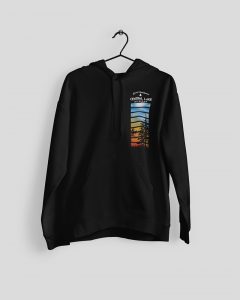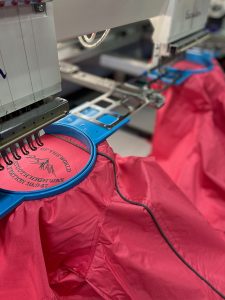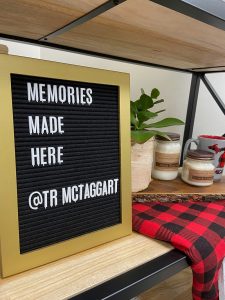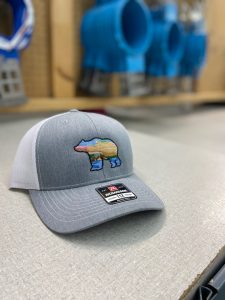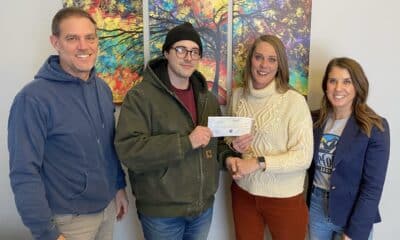LINDSAY CARPENTER’S lightbulb-above-the-head moment came in early 2019 while standing at the end of a dryer.
She was barely four months on the job as the general manager of T.R. McTaggart, a screen printing and embroidery shop in Standish, Michigan, when she realized just how complicated that dryer position could be. Like a catcher in baseball, the person standing in that spot can see the whole field and has to know what everyone is doing and why they’re doing it. They have to know design, they have to understand shipping, and they need to be able to read work orders – all in the midst of still making sure they’re pulling, folding, and boxing up the garments coming down the line.
It needed to be simpler. Everything needed to be simple.
With that, T.R. McTaggart was off in a new direction, undertaking the sort of mind shift and rebrand the company hadn’t seen before in its 50-plus years of existence.
First on the docket was marketing. For decades, T.R. messaged around the services they offered: Screen printing, embroidery, candles, and promotional products, to name a few. Every piece of marketing collateral created and every show they attended focused on telling customers what T.R. McTaggart did. But nothing focused on why they did it.
“There are a lot of companies that can print on a shirt,” says Carpenter. “There are a lot of companies who do what we do, so we needed to think different. We needed to focus not on what a customer can get, but why they should get it from T.R McTaggart.”
Advertisement
That’s how their slogan “Memories Made Here” was born. The T.R. McTaggart team spent hours brainstorming and talking through how to stand out from the competition. Carpenter has a diverse background in marketing and recognized they needed to tell their story and tap into the emotion behind it.
Many of T.R.’s customers are campgrounds, parks, and other tourist destinations where families vacation and share great moments. Most are smaller locations in the Midwest, but T.R. boasts several prominent national clients, as well. The shirts, hats, and souvenirs sold at these destinations are part of the memories people make there. This meant T.R. McTaggart made memories for customers. Literally.
“That was an important moment for us,” Carpenter said. “Not only did it help us connect with our customers more, it really connected with our employees. It helped them understand they have a purpose beyond just making a shirt. They’re making a memory for a family somewhere who will remember all the great times they had every time they look at that shirt. It’s powerful.”
T.R. McTaggart redesigned its web site and marketing collateral with that message in mind. They took a less-is-more approach and focused on making everything simpler. This meant making some hard choices, such as walking away from one of the company’s biggest customers because they were no longer able to service them in a way that made sense with where the new T.R. was headed.
“That was a tough choice,” Carpenter said. “We spent a lot of time trying to be all things to all customers and realized we just couldn’t do it anymore. Our focus was on picking our lane and sticking to it.”
That lane now includes a focus on just tourism, campground, and resort customers. The team spent weeks collecting as much data as it could about those customers, talked to team members, and ultimately profiled their ideal customer. They even gave her a name: Jennifer.
Advertisement
“Jen represents a sort of North Star for us,” Carpenter said. “Everything we make, everything we design we ask ourselves, ‘Will Jen like this? Would she buy it?’ If the answer is no, it’s back to the drawing board.”
T.R. also recognized that Jen does business a little differently these days. The realities of COVID-19 forced an even deeper look in the mirror about how they go to market. Hours-long sales meetings were replaced with Zoom calls and face-to-face visits were swapped out with YouTube videos and Stitch Fix-like sample boxes called “Memory Kits” shipped directly to their best customers for them to keep. The results were almost immediate.
“People were calling us the day they got their memory kit thanking us, thrilled that we sent them,” says Carpenter. “And then they’d say, I’ll take 144 of them.”
T.R. also looked to its own backyard for additional ideas. T.R.’s parent company, Forward Corporation, owns convenience stores and hotels in some of Michigan’s tourism hotbeds. Many sell shirts and souvenirs, as well, which has allowed Carpenter to spot trends and test designs others can’t.
“Being part of Forward is a significant advantage for us,” she says. “Not too many shops can look a customer in the eye and tell them with confidence a particular design will sell. But we can because we’ve tested it.”
Today, two years after her dryer moment, Carpenter and the team are celebrating the best first quarter anyone on staff can recall. Orders are pouring in and they’ve added to their sales and design teams as they set their sights on even bigger goals.
Advertisement
“Now we’re looking to grow even more,” says Carpenter. “We think we’ve carved out a great niche for ourselves and we can’t wait to bring that expertise to more customers across the country.”
For more ideas on how to connect with customers, listen to episode 11 of Screen Saver, featuring Lindsay Carpenter.
PHOTO GALLERY (4 IMAGES)

 Case Studies2 months ago
Case Studies2 months ago
 Art, Ad, or Alchemy2 months ago
Art, Ad, or Alchemy2 months ago
 Andy MacDougall2 months ago
Andy MacDougall2 months ago
 Columns3 weeks ago
Columns3 weeks ago
 Editor's Note3 weeks ago
Editor's Note3 weeks ago
 Marshall Atkinson3 weeks ago
Marshall Atkinson3 weeks ago
 Thomas Trimingham2 months ago
Thomas Trimingham2 months ago
 News & Trends2 months ago
News & Trends2 months ago
